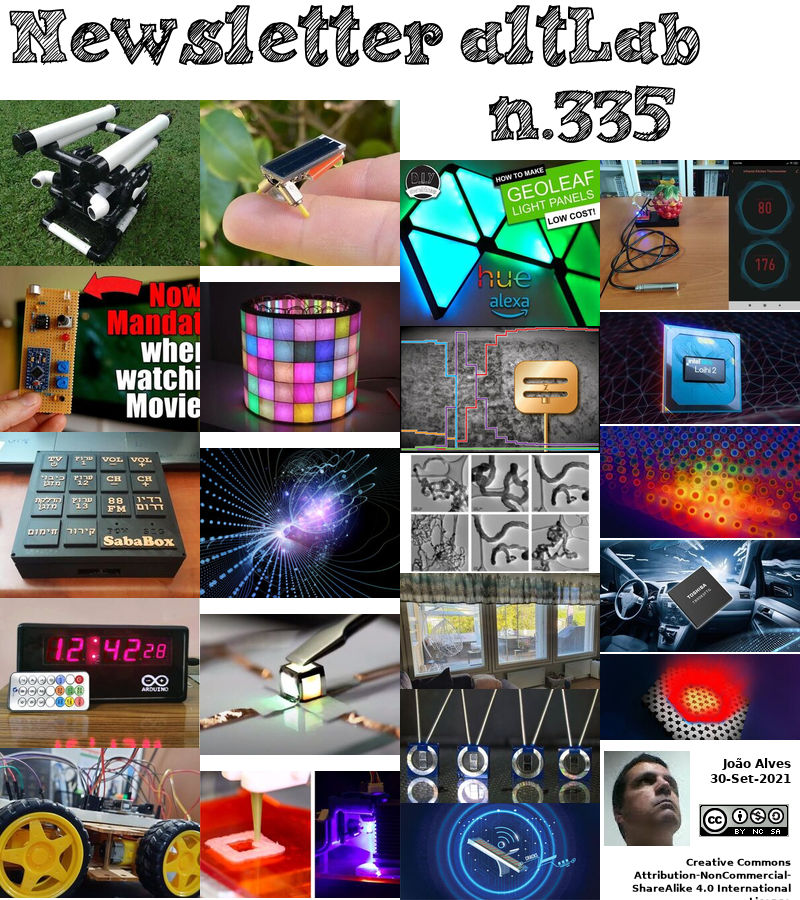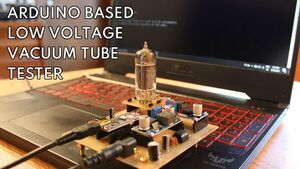2021-09-30 - Nº 335
Editorial
Esta é a Newsletter Nº 335 que se apresenta com o mesmo formato que as anteriores. Se gostar da Newsletter partilhe-a!
Todas as Newsletters encontram-se indexadas no link.
Esta Newsletter tem os seguintes tópicos:
Faz hoje anos que nascia, em 1802, o químico francês Antoine Jérôme Balard. Ele descobriu o elemento bromo, determinou as suas propriedades, e estudou alguns dos seus compostos. Mais tarde, provou a presença de bromo em plantas e animais marinhos. Esta descoberta foi um subproduto de uma investigação química mais geral sobre o mar e as suas formas de vida. O bromo tinha um peso atómico próximo da média aritmética de dois outros halogéneos conhecidos, o cloro e o iodo, sugerindo que formavam uma "família química". Também investigou a extracção barata de sais da água do mar. Descobriu o ácido oxâmico, utilizando o calor para decompor o oxilato de hidrogénio de amónio. Estudou e nomeou o álcool amílico.
Faz também hoje anos que nascia, em 1870, o físico francês Jean Baptiste Perrin. Ele, nos seus estudos sobre o movimento browniano de partículas minúsculas suspensas em líquidos, verificou a explicação de Albert Einstein sobre este fenómeno e confirmou assim a natureza atómica da matéria. Utilizando uma emulsão gamboge, Perrin foi capaz de determinar por um novo método, uma das constantes físicas mais importantes, o número de Avogadro (o número de moléculas de uma substância em tantas gramas como indicado pelo peso molecular, por exemplo, o número de moléculas em duas gramas de hidrogénio). O valor obtido correspondia, dentro dos limites de erro, ao dado pela teoria cinética dos gases. Por esta conquista foi galardoado com o Prémio Nobel da Física em 1926.
Faz igualmente hoje anos que nascia, em 1882, o físico alemão Hans Geiger. Ele introduziu o contador Geiger, o primeiro detector de partículas alfa individuais e outras radiações ionizantes bem sucedidas. Após ter obtido o seu doutoramento na Universidade de Erlangen em 1906, colaborou na Universidade de Manchester com Ernest Rutherford. Utilizou a primeira versão do seu contador de partículas, e outros detectores, em experiências que levaram à identificação da partícula alfa como núcleo do átomo de hélio e à declaração de Rutherford (1912) de que o núcleo ocupa um volume muito pequeno no átomo. O contador Geiger-Müller (desenvolvido com Walther Müller) tinha melhorado a durabilidade, desempenho e sensibilidade para detectar não só partículas alfa mas também partículas beta (electrões) e fótons electromagnéticos ionizantes. Geiger regressou à Alemanha em 1912 e continuou a investigar os raios cósmicos, a radioactividade artificial, e a fissão nuclear.
Faz também hoje anos que nascia, em 1905, o físico inglês Nevill Francis Mott. Ele partilhou (com PhilipW. Anderson e John H. Van Vleck dos EUA) o Prémio Nobel da Física de 1977 pelas suas pesquisas independentes sobre as propriedades magnéticas e eléctricas dos semicondutores amorfos. Enquanto as propriedades eléctricas dos cristais são descritas pela Teoria da Banda - que compara a condutividade dos metais, semicondutores, e isoladores - uma famosa excepção é fornecida pelo óxido de níquel. Segundo a teoria da banda, o óxido de níquel deveria ser um condutor metálico mas na realidade é um isolante. Mott refinou a teoria para incluir a interacção electrão-electrão e explicou as chamadas transições Mott, através das quais alguns metais se tornam isoladores à medida que a densidade de electrões diminui, separando os átomos uns dos outros de alguma forma conveniente.
Faz igualmente hoje anos que nascia, em 1917, o inventor norte-americano Irving B. Kahn. Ele inventou o teleprompter. Em meados dos anos 50, Kahn concebeu e construiu o que foi talvez o primeiro sistema de projecção traseira controlada remotamente e com várias imagens no mundo para as instalações do exército dos EUA em Huntsville, Ala., para fazer apresentações persuasivas aos congressistas visitantes. Com cinco imagens (uma grande, 3¼ por 4 diapositivos ou imagem de filme no centro, flanqueada por diapositivos menores em cada lado) e acesso aleatório, poderia pesquisar e seleccionar entre 500 diapositivos. TelePrompTer também fez muitas contribuições tecnológicas para a primitiva indústria da televisão por cabo. Em 1961, Kahn e Hub Schlafley demonstraram a Key TV, um conceito precoce de TV paga, ao mostrar o segundo combate de pesos pesados Patterson vs. Johansson, dando essencialmente origem a pay-per-view.
Faz também hoje anos que nascia, em 1939, o químico francês Jean-Marie Lehn. Ele partilhou (com Charles J. Pedersen e Donald J. Cram) o Prémio Nobel da Química de 1987, pela sua contribuição para a síntese laboratorial de moléculas que imitam as funções químicas vitais das moléculas nos organismos vivos. Tais moléculas têm uma interacção altamente selectiva e específica da estrutura. Estas moléculas podem "reconhecer-se" umas às outras e escolher com que outras moléculas irão formar complexos. De baixo peso molecular e com propriedades muito especiais, as moléculas destes compostos ligam-se de forma selectiva, como uma chave encaixa numa fechadura.
Por fim, faz hoje anos que nascia, em 1943, o bioquímico alemão Johann Deisenhofer. Ele recebeu o Prémio Nobel da Química de 1988, juntamente com Hartmut Michel e Robert Huber, pela determinação da estrutura tridimensional de certas proteínas essenciais à fotossíntese. Utilizando a cristalografia de raios X (1982-85), desvendaram todos os detalhes de como uma proteína ligada à membrana é construída, revelando a estrutura do átomo da molécula por átomo. A proteína foi retirada de uma bactéria que, como as plantas verdes e as algas, utiliza a energia da luz solar para construir substâncias orgânicas. A fotossíntese em bactérias é mais simples do que em algas e plantas superiores, mas o trabalho levou a uma maior compreensão da fotossíntese também nesses organismos.
Em 1982, H. Ross Perot e Jay Colburn completaram a primeira circum-navegação do mundo num helicóptero, o Espírito do Texas. A sua viagem começou 29 dias, 3 horas, e 8 minutos antes, a 1 de Setembro. Para a sua viagem à volta do mundo, que começou e terminou em Fort Worth, Texas, Perot e Coburn pilotaram um Long Ranger com equipamento de navegação completo, equipamento de sobrevivência, e artigos de emergência. Foram adicionados flutuadores pop-out, e um tanque de combustível auxiliar de 151 galões no lugar do assento traseiro foi utilizado para permitir ao Spirit of Texas voar oito horas sem reabastecimento. Um motor de turbina Allison 250-C28B funcionou sem falhas durante 246,5 horas de voo, voando mais de 10 horas por dia, sobre o mar aberto, deserto estéril, e floresta tropical com uma velocidade média no solo de 117 mph.
Nesta semana que passou ficámos a saber que o helicóptero Ingenuity, que se encontra na superfície de Marte, realizou um teste de rotação a alta velocidade a 2.800 RPM no solo e que se tudo corresse bem, o passo seguinte seria realizar um voo de curta duração, pairando brevemente sobre a localização actual, com uma velocidade de rotor de 2.700 RPM. No entanto, acabou por ser um voo sem incidentes, porque o Ingenuity decidiu não levantar voo. O equipamento detectou uma anomalia em dois dos pequenos servomotores de controlo de voo (ou simplesmente "servos") durante o seu checkout automático de pré-voo e fez exactamente o que era suposto fazer: Cancelou o voo.
Na Newsletter desta semana apresentamos diversas noticias, artigos científicos, projetos de maker assim como alguns videos interessantes. São apresentadas as revistas MagPI Nº110 e a HackSpaceMag Nº47 de Outubro.
 João Alves ([email protected])
João Alves ([email protected])
O conteúdo da Newsletter encontra-se sob a licença  Creative Commons Attribution-NonCommercial-ShareAlike 4.0 International License.
Creative Commons Attribution-NonCommercial-ShareAlike 4.0 International License.
Novidades da Semana

2,800 RPM Spin a Success, but Flight 14 Delayed to Post Conjunction
"It’s been an eventful several Martian days, or sols, since our last blog post, so we wanted to provide everyone with an update on where things stand on Mars. In our last post, we explained that we were getting ready to begin flying with a higher rotor speed to compensate for decreasing atmospheric density caused by seasonal changes on Mars. Increasing the rotor speed is a significant change to how we’ve been flying thus far, so we wanted to proceed forward carefully. Step one was to perform a high-speed spin test at 2,800 rpm on the ground and, if everything went well, step two was to perform a short-duration flight, briefly hovering over our current location, with a 2,700 rpm rotor speed. The high-speed spin test was completed successfully on Sept. 15, 2021 at 23:29 PDT, 11:11 LMST local Mars time (Sol 204 of the Perseverance mission). Ingenuity’s motors spun the rotors up to 2,800 rpm, briefly held that speed, and then spun the rotors back down to a stop, all exactly as sequenced for the test." [...]
Outras Notícias

Sony to Release UV Wavelength-Compatible CMOS Image Sensor Equipped with Global Shutter Function and Industry’s Highest Effective Pixel Count of Approx. 8.13 Megapixels
"Sony Semiconductor Solutions Corporation (Sony) today announced the commercialization of the IMX487, a 2/3-type CMOS image sensor for industrial equipment, which is compatible with the UV (ultraviolet light) wavelength and comes with global shutter functionality and the industry’s highest*1 effective pixel count of approximately 8.13 megapixels. *2 This product delivers a high level of UV sensitivity and high-quality imaging with minimal noise thanks to components specialized for the UV wavelength and a unique light receiving unit structure. Additionally, the pixels capture UV light with high efficiency, resulting in high UV sensitivity as well as a compact form factor and high resolution made possible by the industry’s smallest*1 2.74 µm square pixel size. It utilizes Sony’s Pregius S global shutter technology, which employs a unique back-illuminated pixel structure on a stacked CMOS image sensor, ensuring distortion-free imaging and high-speed performance. Sony expects the new sensor to be useful in a variety of applications, including semiconductor pattern defect inspection in the existing UV camera market, thereby contributing to improving productivity in manufacturing processes and helping to solve industrial issues. In general, UV cameras enable sorting of materials that would be difficult in visible light, as well as checking for minute scratches and defects on the surface of objects." [...]

Toshiba Starts Sample Shipments of Pre-Driver IC for Automotive Brushless Motors Supporting Functional Safety
"Toshiba Electronic Devices & Storage Corporation ("Toshiba") has begun shipping test samples of "TB9083FTG," a pre-driver IC for automotive applications that include brushless motors for electric power steering systems and electric brakes. Toshiba will ship final samples in January 2022, and will start mass production in December 2022. TB9083FTG is a three-phase pre-driver that controls and drives external N-channel power MOSFETs for driving a three-phase brushless DC motor. It supports ASIL-D[1] functional safety[2] and its compliance with ISO 26262 2nd edition allows use in for highly safety-critical automotive systems. The new IC has a built-in three-channel pre-driver for the safety relays that control and drive the relays for motors and power supply. This eliminates the need for external components and helps reduce the part count." [...]

Intel Advances Neuromorphic with Loihi 2, New Lava Software Framework and New Partners
"Today, Intel introduced Loihi 2, its second-generation neuromorphic research chip, and Lava, an open-source software framework for developing neuro-inspired applications. Their introduction signals Intel’s ongoing progress in advancing neuromorphic technology. “Loihi 2 and Lava harvest insights from several years of collaborative research using Loihi. Our second-generation chip greatly improves the speed, programmability, and capacity of neuromorphic processing, broadening its usages in power and latency constrained intelligent computing applications. We are open sourcing Lava to address the need for software convergence, benchmarking, and cross-platform collaboration in the field, and to accelerate our progress toward commercial viability.” –Mike Davies, director of Intel’s Neuromorphic Computing Lab Why It Matters: Neuromorphic computing, which draws insights from neuroscience to create chips that function more like the biological brain, aspires to deliver orders of magnitude improvements in energy efficiency, speed of computation and efficiency of learning across a range of edge applications: from vision, voice and gesture recognition to search retrieval, robotics, and constrained optimization problems. Applications Intel and its partners have demonstrated to date include robotic arms, neuromorphic skins and olfactory sensing." [...]
Nordic Semiconductor’s Arm dual-core nRF5340 SoC shortlisted in World Electronics Achievement Awards
"The world first SoC offering two Arm Cortex-M33 processors nominated in RF/Wireless/Microwave category of global awards Nordic Semiconductor today announces that its nRF5340™ high-end multiprotocol System-on-Chip (SoC), the world’s first SoC based on an Arm® Cortex-M33 dual-processor hardware architecture, has been shortlisted as a finalist in the ‘RF/Wireless/Microwave’ product category of the 2021 World Electronics Achievement Awards (WEAA). Outstanding innovation The WEAA program honors products, companies, and individuals that have made outstanding contributions to innovation and development in the global electronics industry, and have demonstrated leadership and excellent performance. Organized by the world’s largest electronics industry media group, ASPENCORE, the winners will be determined by a judging panel comprising editors, senior industry analysts, online readers, and product users worldwide. With our nRF Connect SDK we also help make these complex applications much easier and simpler to implement Bjørn Åge “Bob” Brandal, Nordic Semiconductor Recognized as the world’s leading Bluetooth® Low Energy (Bluetooth LE) semiconductor chip company, Nordic has evolved into a wireless IoT firm able to ‘connect anything’ via ultra low power, short-range wireless technologies such as Bluetooth LE; or low-power, long-range wireless technologies such as the latest IoT-targeted versions of cellular wireless technology, LTE-M and NB-IoT. The nRF5340 SoC is the world’s first wireless SoC with two Arm® Cortex®-M33 processors, a high performance application processor capable of DSP and Floating Point, offering voltage and frequency scaling options and running up to 128MHz (514 CoreMark) with dedicated 1MB Flash and 512KB RAM, and a fully programmable, ultra low power network processor running at 64MHz (244 CoreMark) with dedicated 256KB Flash and 64KB RAM. It is a comprehensive solution for the most complex IoT applications, and features High-Speed USB, multiprotocol capability (supporting Bluetooth 5.2, LE Audio, Bluetooth Direction Finding, Long Range, Bluetooth mesh, Thread, Zigbee, ANT™, IEEE 802.15.4, NFC and proprietary 2.4GHz RF protocol software), as well as trusted execution, root-of-trust, and secure key storage security features through Arm TrustZone® technology." [...]

TI's integrated transformer module technology helps maximize drive time in hybrid and electric vehicles
"Engineers can meet the need for smaller, lighter systems by cutting power solution size in half with new easy-to-use, bias-supply module Texas Instruments (TI) (Nasdaq: TXN) today introduced the industry’s smallest and most accurate 1.5-W isolated DC/DC bias-supply module. The UCC14240-Q1 uses a proprietary integrated transformer technology to enable designers to cut their power solution size in half for use in high-voltage environments such as electric vehicles (EVs), hybrid EVs, motor-drive systems and grid-tied inverters. For more information, see ti.com/UCC14240-Q1-pr. With the accelerating growth of the EV market, automotive design engineers are looking for ways to improve efficiency and reliability, while also reducing the weight of the heaviest part of the EV: the powertrain. To help meet the need for smaller, more reliable systems to extend driving range, engineers are moving to a distributed power architecture, a scheme where every isolated gate driver has a dedicated bias supply. This architecture improves how the system reacts to single-point failures." [...]
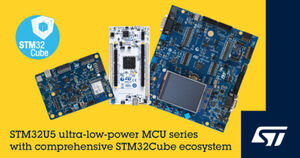
STMicroelectronics’ STM32 Ecosystem Extensions Kick-Start Development with STM32U5 Extreme Low-Power Microcontrollers
"STMicroelectronics has announced new STM32Cube software packs and tools, as well as evaluation boards, to accelerate development with the latest STM32U5 microcontrollers (MCUs), which are now ready for mass-market applications with stock at authorized distributors. The STM32U575 and STM32U585 MCUs combine security and power-saving innovations with the increased performance and energy efficiency of the latest Arm® Cortex®-M33 core. With up to 2MB of Flash memory on-chip, typical applications include smart, connected consumer products such as activity trackers and smart watches, as well as smart-home equipment, utility meters, equipment for industrial sensing and signaling, mobile point-of-sale (POS) terminals, insulin pumps, and glucose meters. As the first STM32 MCUs to leverage advanced 40nm process technology, the STM32U5 series delivers superior feature integration, memory density, dynamic power consumption, and standby power compared to alternative products in the market. There are also new power-saving features including a Low Power Background Autonomous Mode (LPBAM) that lets direct memory access (DMA) and key peripherals operate without CPU intervention. With an updated ST ART Accelerator™, the ability to turn off unused MCU memory, and a selectable DC/DC converter and low-dropout (LDO) regulator combination, dynamic power is less than 19µA/MHz." [...]

AMD Announces Ambitious Goal to Increase Energy Efficiency of Processors Running AI Training and High Performance Computing Applications 30x by 2025
"AMD today announced a goal to deliver a 30x increase in energy efficiency for AMD EPYC CPUs and AMD Instinct accelerators in Artificial Intelligence (AI) training and High Performance Computing (HPC) applications running on accelerated compute nodes by 2025.1 Accomplishing this ambitious goal will require AMD to increase the energy efficiency of a compute node at a rate that is more than 2.5x faster than the aggregate industry-wide improvement made during the last five years. Accelerated compute nodes are the most powerful and advanced computing systems in the world used for scientific research and large-scale supercomputer simulations. They provide the computing capability used by scientists to achieve breakthroughs across many fields including material sciences, climate predictions, genomics, drug discovery and alternative energy. Accelerated nodes are also integral for training AI neural networks that are currently used for activities including speech recognition, language translation and expert recommendation systems, with similar promising uses over the coming decade. The 30x goal would save billions of kilowatt hours of electricity in 2025, reducing the power required for these systems to complete a single calculation by 97% over five years. “Achieving gains in processor energy efficiency is a long-term design priority for AMD and we are now setting a new goal for modern compute nodes using our high-performance CPUs and accelerators when applied to AI training and high-performance computing deployments,” said Mark Papermaster, executive vice president and CTO, AMD." [...]

Renesas Introduces Highly Accurate, Cost-Effective Pressure Sensing Solution for Automotive Applications
"New RAA2S425x Product Family Integrates Multiple Analog and Digital Functions to Reduce Design Time and Costs of xEV/EV/FCEV Pressure Sensing Braking, Transmission and HVAC Systems. Renesas Electronics Corporation (TSE:6723), a premier supplier of advanced semiconductor solutions, today introduced the RAA2S425x Family of ICs for automotive pressure sensing systems. The new devices provide highly accurate amplification and sensor-specific correction of signals in automotive xEV/EV/FCEV pressure sensing braking, transmission and HVAC systems. The RAA2S425x Product Family features high integration and advanced digital and analog functionality that significantly ease the design cycle and reduce customers' system BOM and production costs. The RAA2S425x ICs support all major pressure sensing technologies and feature a high-performance analog front-end (AFE) for enhanced signal conditioning. The new devices offer extended analog sensor offset compensation (XSOC), adjustable to nearly all resistive bridges." [...]
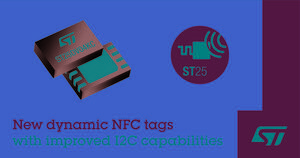
STMicroelectronics Boosts Flexibility and Speed with Enhancements to ST25DV Dual-Interface NFC Tags
"STMicroelectronics has increased the I2C-interface performance in the latest generation of its ST25DV-I2C dynamic NFC-tag ICs, which let the host system access the tag’s on-chip EEPROM more quickly and easily. Writing to the EEPROM on the new ST25DV-I2C tags, via the I2C interface, is now as fast as standard EEPROM and allows flexible use of the tag to reduce system bill-of-materials costs. Also, designers can now configure the tag’s I2C address to ensure coexistence with other devices on the bus. As a Type 5 NFC tag certified by the NFC Forum, the ST25DV-I2C supports contactless interaction with 13.56MHz RFID readers and NFC phones, permitting common use cases such as tap-to-connect pairing with NFC Data Exchange Format (NDEF) messages. The new tags also extend wireless capabilities, including support for arbitration that allows more convenient access to data written into the EEPROM through the RF interface. With its extra performance and flexibility, this latest evolution of the ST25DV-I2C boosts productivity and efficiency in industrial applications such as smart metering, asset tracking, and logistics, and brings superior user experiences to medical equipment, smart-home devices and lighting, smart retail labels, and consumer products." [...]

Renesas Launches RX140 MCUs with 2x Performance and Over 30 Percent Better Power Efficiency for Home and Industrial Applications
"New Ultra-Low Power RX140 MCUs Realize Improved Noise Tolerance and Sensing Accuracy Through Advanced Touch Sensing. Renesas Electronics Corporation (TSE:6723), a premier supplier of advanced semiconductor solutions, today introduced the ultra-low power, 32-bit RX140 group of microcontrollers (MCUs), the latest addition to its entry-level RX100 Series. Built around Renesas’ powerful RXv2 CPU core, the RX140 MCUs deliver outstanding performance, with operation of up to 48 MHz with a CoreMark score of 204, equivalent to approximately twice the processing performance of the RX130 group. The RX140 MCUs also boost power efficiency by over 30 percent compared with previous RX130 MCUs, achieving power consumption as low as 56 µA/MHz when the CPU is in active mode and as low as 0.25 µA in standby mode. This enables the RX140 MCUs to realize high performance and low power consumption in a wide range of products, such as home appliances, industrial and building automation (BA). The RX140 MCUs feature the latest capacitive touch sensing units, offering customers an enhanced user experience (UX) and user interface (UI)." [...]

Samsung Moves Ahead in Mobile SoC Technologies With Its Comprehensive 5G VoNR Solution
"Samsung Electronics announced that it has developed its comprehensive VoNR (Voice over New Radio) solution for 5G voice call service, available for global mobile device manufacturers and network providers. With the comprehensive solution for VoNR, Samsung offers more streamlined SoC development and 5G VoNR service deployment. VoNR technology supports both voice call and data service using the 5G network while the current 5G network approach switches into 4G network when making voice calls. Without the need for switching between networks, VoNR provides a higher chance of maintaining connection in voice call as well as faster call connection times. Users can also enjoy true 5G speeds when playing high-performance games or streaming high-quality videos even while staying on a call. Samsung’s VoNR solution includes key technologies such as an IP Multimedia Subsystem (IMS), Quality of Service (QoS), and handover." [...]

Renesas Introduces Industry’s Highest Performance Entry-Line MCUs
"New RA6E1 Group Based on Arm® Cortex®-M33 Delivers 200 MHz Performance in Addition to Low Power Performance Renesas Electronics Corporation (TSE:6723), a premier supplier of advanced semiconductor solutions, today introduced a new Group of 32-bit microcontrollers (MCUs) in its RA Family. The new RA6E1 MCUs, based on the Arm® Cortex®-M33 core, are the industry’s first Entry-Line MCUs to deliver 200 MHz performance. The new devices also provide exceptional low power consumption specifications, along with a rich list of peripheral features. Renesas’ RA Family MCUs are differentiated by a unique combination of very low power consumption, best-in-class security options, including Arm TrustZone® technology, and Renesas’ Flexible Software Program (FSP) that supports all RA Family offerings. The FSP includes highly efficient drivers and middleware to ease the implementation of communications and security. The FSP’s GUI simplifies and accelerates the development process." [...]

Samsung Electronics Puts Forward a Vision To ‘Copy and Paste’ the Brain on Neuromorphic Chips
"With Harvard Researchers, Samsung introduces a new approach to reverse engineer the brain on a memory chip, in a Perspective paper published in Nature Electronics Samsung Electronics, a world leader in advanced semiconductor technology, today shared a new insight that takes the world a step closer to realizing neuromorphic chips that can better mimic the brain. Envisioned by the leading engineers and scholars from Samsung and Harvard University, the insight was published as a Perspective paper, titled ‘Neuromorphic electronics based on copying and pasting the brain’, by Nature Electronics. Donhee Ham, Fellow of Samsung Advanced Institute of Technology (SAIT) and Professor of Harvard University, Professor Hongkun Park of Harvard University, Sungwoo Hwang, President and CEO of Samsung SDS and former Head of SAIT, and Kinam Kim, Vice Chairman and CEO of Samsung Electronics are the co-corresponding authors. The essence of the vision put forward by the authors is best summed up by the two words, ‘copy’ and ‘paste’. The paper suggests a way to copy the brain’s neuronal connection map using a breakthrough nanoelectrode array developed by Dr. Ham and Dr. Park, and to paste this map onto a high-density three-dimensional network of solid-state memories, the technology for which Samsung has been a world leader. Through this copy and paste approach, the authors envision to create a memory chip that approximates the unique computing traits of the brain – low power, facile learning, adaptation to environment, and even autonomy and cognition – that have been beyond the reach of current technology." [...]

NASA’s Perseverance Rover Cameras Capture Mars Like Never Before
"Scientists tap into an array of imagers aboard the six-wheeled explorer to get a big picture of the Red Planet. NASA’s Perseverance rover has been exploring Jezero Crater for more than 217 Earth days (211 Martian days, or sols), and the dusty rocks there are beginning to tell their story – about a volatile young Mars flowing with lava and water. That story, stretching billions of years into the past, is unfolding thanks in large part to the seven powerful science cameras aboard Perseverance. Able to home in on small features from great distances, take in vast sweeps of Martian landscape, and magnify tiny rock granules, these specialized cameras also help the rover team determine which rock samples offer the best chance to learn whether microscopic life ever existed on the Red Planet. Altogether, some 800 scientists and engineers around the world make up the larger Perseverance team. That includes smaller teams, from a few dozen to as many as 100, for each of the rover’s cameras and instruments." [...]
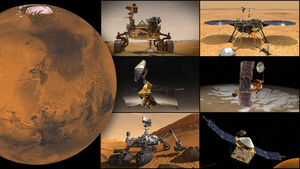
NASA’s Mars Fleet Lies Low With Sun Between Earth and Red Planet
"The missions will continue collecting data about the Red Planet, though engineers back on Earth will stop sending commands to them until mid-October. NASA will stand down from commanding its Mars missions for the next few weeks while Earth and the Red Planet are on opposite sides of the Sun. This period, called Mars solar conjunction, happens every two years. The Sun expels hot, ionized gas from its corona, which extends far into space. During solar conjunction, when Earth and Mars can’t “see” each other, this gas can interfere with radio signals if engineers try to communicate with spacecraft at Mars. That could corrupt commands and result in unexpected behavior from our deep space explorers." [...]

First RISC-V computer chip lands at the European Processor Initiative
"The European Processor Initiative (EPI) has run the successful first test of its RISC-V-based European Processor Accelerator (EPAC), touting it as the initial step towards homegrown supercomputing hardware. EPI, launched back in 2018, aims to increase the independence of Europe's supercomputing industry from foreign technology companies. At its heart is the adoption of the free and open-source RISC-V instruction set architecture for the development and production of high-performance chips within Europe's borders. The project's latest milestone is the delivery of 143 samples of EPAC chips, accelerators designed for high-performance computing applications and built around the free and open-source RISC-V instruction set architecture. Designed to prove the processor's design, the 22nm test chips – fabbed at GlobalFoundries, the not-terribly-European semiconductor manufacturer spun out of AMD back in 2009 – have passed initial testing, running a bare-metal "hello, world" program as proof of life. It's a rapid turnaround." [...]
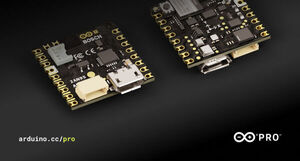
Arduino Nicla Sense ME makes sense of the world
"Nicla is Arduino Pro’s new family of modular, intelligent products that are easy to use, versatile and accessible – whether you are an advanced user working on industrial applications or a budding maker looking to prototype your first intelligent solution. No wonder it’s named after the Greek word for “victory of the people!” To herald the range, we have just released the Nicla Sense ME: a tiny but mighty board, co-developed with Bosch Sensortec to enable sensing and intelligence on the edge. With low-power sensors, a high-performance processor and small footprint, it offers a winning combination that can answer our community’s and clients’ needs and open up to opportunities for infinite new solutions. What makes the Nicla Sense ME so special? Let’s dive into some details. Sense motion and the environment At the Sense ME’s heart, you’ll find Bosch Sensortec’s BHI260AP AI sensor system with integrated motion sensor, BMM150 magnetometer, BPM390 pressure sensor, and the unique BME688 4-in-1 gas sensor with AI and integrated high-linearity, and high-accuracy pressure, humidity and temperature sensors." [...]
Ciência e Tecnologia

UChicago scientists create material that can both move and block heat
"Unusual material could improve the reliability of electronics and other devices Moving heat around where you want it to go—adding it to houses and hairdryers, removing it from car engines and refrigerators—is one of the great challenges of engineering. All activity generates heat, because energy escapes from everything we do. But too much can wear out batteries and electronic components—like parts in an aging laptop that runs too hot to actually sit on your lap. If you can’t get rid of heat, you’ve got a problem. Scientists at the University of Chicago have invented a new way to funnel heat around at the microscopic level: a thermal insulator made using an innovative technique. They stack ultra-thin layers of crystalline sheets on top of each other, but rotate each layer slightly, creating a material with atoms that are aligned in one direction but not in the other." [...]
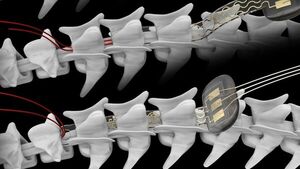
New photoelectric implant controls the activity of spinal neurons
"A revolutionary implant developed at EPFL allows neuroscientists to activate or inhibit specific spinal-cord neurons by applying light at a specific wavelength. It will give researchers insight into how the nervous system works and the chance to develop new ways of treating neurological disorders. Grégoire Courtine doesn’t hesitate to use the word “revolutionary” when describing the emerging field of optogenetics – a technology that uses pulses of light to control individual neural activity – and what it could mean for neuroscience. Courtine, director of the NeuroRestore research center (with neurosurgeon Jocelyne Bloch), is currently developing an optogenetic implant together with Stéphanie Lacour, who holds the Bertarelli Foundation Chair in Neuroprosthetic Technology. “Our system allows us to control the activity of any neuron in the spinal cord,” says Courtine. “In turn, this helps us to understand the role it plays in the overall functioning of the nervous system.” The key to their breakthrough is the new implant technology developed by Lacour’s research group." [...]

Connecting the Dots Between Material Properties and Qubit Performance
"Brookhaven Lab and Princeton scientists team up to identify sources of loss of quantum information at the atomic scale. Engineers and materials scientists studying superconducting quantum information bits (qubits)—a leading quantum computing material platform based on the frictionless flow of paired electrons—have collected clues hinting at the microscopic sources of qubit information loss. This loss is one of the major obstacles in realizing quantum computers capable of stringing together millions of qubits to run demanding computations. Such large-scale, fault-tolerant systems could simulate complicated molecules for drug development, accelerate the discovery of new materials for clean energy, and perform other tasks that would be impossible or take an impractical amount of time (millions of years) for today’s most powerful supercomputers. An understanding of the nature of atomic-scale defects that contribute to qubit information loss is still largely lacking. The team helped bridge this gap between material properties and qubit performance by using state-of-the-art characterization capabilities at the Center for Functional Nanomaterials (CFN) and National Synchrotron Light Source II (NSLS-II), both U.S. Department of Energy (DOE) Office of Science User Facilities at Brookhaven National Laboratory." [...]

At the extreme: Breaking the ice mold
"New research involving Lawrence Livermore National Laboratory (LLNL) scientists shows that water can remain liquid in a metastable state when transitioning from liquid to a dense form of ice at higher pressures than previously measured. Water at extreme conditions has attracted recent attention because of its complex phase diagram, including superionic ice phases having exotic properties that exist at high pressures and densities. To date, 20 unique crystalline ice phases have been found naturally on Earth or in the laboratory. Water also exhibits bizarre metastable phenomena when compressed or cooled very rapidly, which have attracted interest from physicists worldwide for many years. “If the water is compressed very rapidly, it will remain liquid in a metastable state until finally crystallizing into ice VII at a higher pressure than expected,” said Michelle Marshall, a research scientist at the Laboratory for Laser Energetics (LLE) at the University of Rochester, a former LLNL postdoc and lead author of the study appearing in Physical Review Letters. Ice VII is the stable polymorph of water at room temperature and at pressures exceeding ∼2 GPa (more than 19,000 atmospheres]." [...]

Ultrathin quantum dot LED that can be folded freely as paper
"The new device can be folded into complex 3D structures such as butterflies, airplanes, and pyramids Quantum dot light-emitting diode (QLED), which employs quantum dots as a light-emitting material, has attracted significant attention as a promising alternative for next-generation display technologies, owing to its outstanding electroluminescence properties. Since it does not require any bulky components such as backlight units, QLED displays can potentially be manufactured into an ultrathin form factor. A joint research team led by KIM Dae-Hyeong (Professor at Seoul National University) and HYEON Taeghwan (Distinguished professor at Seoul National University) from the Center for Nanoparticle Research within the Institute for Basic Science has previously unveiled a prototype QLED back in 2015. The device had a thickness of only 3 micrometers, which is only one-thirtieth of that of human hair. Due to such an extremely reduced thickness, the ultrathin QLED exhibited outstanding mechanical flexibility, which allowed it to be readily applicable in various wearable devices, such as electronic tattoos. Recently, the team further advanced this technology and developed a foldable variant of the ultrathin QLED, inspired by the ancient art of paper folding known as origami." [...]

Researchers develop new method for detecting superfluid motion
"Researchers at Rochester Institute of Technology are part of a new study that could help unlock the potential of superfluids—essentially frictionless special substances capable of unstopped motion once initiated. A team of scientists led by Mishkat Bhattacharya, an associate professor at RIT’s School of Physics and Astronomy and Future Photon Initiative, proposed a new method for detecting superfluid motion in an article published in Physical Review Letters. Scientists have previously created superfluids in liquids, solids, and gases, and hope harnessing superfluids’ properties could help lead to discoveries such as a superconductor that works at room temperature. Bhattacharya said such a discovery could revolutionize the electronics industry, where loss of energy due to resistive heating of wires incurs major costs. However, one of the main problems with studying superfluids is that all available methods of measuring the delicate superfluid rotation bring the motion to a halt. Bhattacharya and his team of RIT postdoctoral researchers teamed up with scientists in Japan, Taiwan, and India to propose a new detection method that is minimally destructive, in situ, and in real-time." [...]

A New Solid-state Battery Surprises the Researchers Who Created It
"Engineers create a high performance all-solid-state battery with a pure-silicon anode. Engineers created a new type of battery that weaves two promising battery sub-fields into a single battery. The battery uses both a solid state electrolyte and an all-silicon anode, making it a silicon all-solid-state battery. The initial rounds of tests show that the new battery is safe, long lasting, and energy dense. It holds promise for a wide range of applications from grid storage to electric vehicles. The battery technology is described in the Sept. 24, 2021 issue of the journal Science." [...]

Topological vertical cavity laser arrays
"Israeli and German researchers have developed a way to force an array of vertical cavity lasers to act together as a single laser - a highly effective laser network the size of a grain of sand. The findings are presented in a new joint research paper published online by the prestigious journal Science on Friday, September 24. Cell phones, car sensors or data transmission in fiber optic networks are all using so called Vertical-Cavity Surface-Emitting Lasers (VCSELs) – semiconductor lasers that are firmly anchored in our everyday technology. Though widely used, the VCSEL device has miniscule size of only a few microns, which sets a stringent limit on the output power it can generate. For years, scientists have sought to enhance the power emitted by such devices through combining many tiny VCSELs and forcing them to act as a single coherent laser, but had limited success. The current breakthrough uses a different scheme: it employs a unique geometrical arrangement of VCSELs on the chip that forces the flight to flow in a specific path – a photonic topological insulator platform." [...]

New models to explore the microstructure of polymer mixtures
"Wing-Hin Wong defended his thesis at the department of Mechanical Engineering on September 22nd. A well-known method for making polymer materials is to blend or mix multiple polymers. For disperse blends, two liquid polymers do not mix well with each other, leading to a so-called droplet-in-matrix microstructure which is similar to emulsions of oil and water. The material properties of the polymer blend depend on the final microstructure, so the material properties can be tuned during processing history. However, conclusively connecting the final microstructure to the processing history with numerical models is the subject of ongoing research. For his PhD research, Wing-Hin Wong extended and improved existing numerical models to better describe this connection." [...]

Winged microchip is smallest-ever human-made flying structure
"The size of a grain of sand, dispersed microfliers could monitor air pollution, airborne disease and environmental contamination. About the size of a grain of sand, the new flying microchip (or “microflier”) does not have a motor or engine. Instead, it catches flight on the wind — much like a maple tree’s propeller seed — and spins like a helicopter through the air toward the ground. By studying maple trees and other types of wind-dispersed seeds, the engineers optimized the microflier’s aerodynamics to ensure that it — when dropped at a high elevation — falls at a slow velocity in a controlled manner. This behavior stabilizes its flight, ensures dispersal over a broad area and increases the amount of time it interacts with the air, making it ideal for monitoring air pollution and airborne disease. As the smallest-ever human-made flying structures, these microfliers also can be packed with ultra-miniaturized technology, including sensors, power sources, antennas for wireless communication and embedded memory to store data." [...]
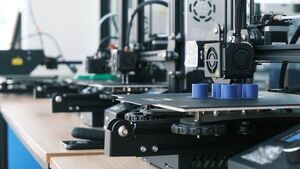
Model Advances Understanding of Incorporating 3D Printing Into Supply Chains
"Getting spare parts where they need to go in a quick, reliable way is a logistical challenge for military and industrial supply chains. Researchers from the U.S. Military Academy at West Point and North Carolina State University have developed a computational model to help determine how best to incorporate additive manufacturing (AM) technologies into these spare parts supply chains. AM technologies, or “3D printers,” hold tremendous potential for alleviating some of the logistical challenges associated with providing spare parts when and where they are needed. However, AM technologies can be expensive and tricky to transport. They also require personnel who have specialized training. What’s more, spare parts supply chains can be particularly complicated, because there is usually intermittent demand – meaning you likely don’t know when you’ll need to provide a particular part or how many parts might be needed at any point in time." [...]

SpaceX satellite signals used like GPS to pinpoint location on Earth
"Engineering researchers have developed a method to use signals broadcast by Starlink internet service satellites to accurately locate a position here on Earth, much like GPS does. It is the first time the Starlink system has been harnessed by researchers outside SpaceX for navigation. The Starlink satellites, sent into orbit by Elon Musk’s SpaceX, are designed to provide broadband internet connections in remote locations around the world. The researchers used signals from six Starlink satellites to pinpoint a location on Earth within 8 meters of accuracy. Their findings, shared today (Sept. 22, 2021) at the Institute of Navigation GNSS annual meeting in St. Louis, may provide a promising alternative to GPS. Their results will be published in the upcoming issue of the journal IEEE Transactions on Aerospace and Electronic Systems." [...]

Skoltech scientists use supercomputer to probe limits of Google’s quantum processor
"CPQM’s Laboratory for Quantum Information Processing has collaborated with the CDISE supercomputing team “Zhores” to emulate Google’s quantum processor. Reproducing noiseless data following the same statistics as Google’s recent experiments, the team was able to point to a subtle effect lurking in Google’s data. This effect, called a reachability deficit, was discovered by the Skoltech team in its past work. The numerics confirmed that Google’s data was on the edge of a so-called, density-dependent avalanche, which implies that future experiments will require significantly more quantum resources to perform quantum approximate optimization. The results are published in the field’s leading journal Quantum. From the early days of numerical computing, quantum systems have appeared exceedingly difficult to emulate, though the precise reasons for this remain a subject of active research." [...]
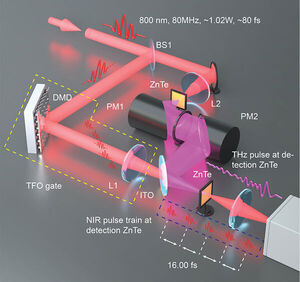
New technique speeds measurement of ultrafast pulses
"Rochester researchers next will aim for a combination of spatial, temporal imaging When we look at an object with our eyes, or with a camera, we can automatically gather enough pixels of light at visible wavelengths to have a clear image of what we see. However, to visualize a quantum object or phenomenon where the illumination is weak, or emanating from nonvisible infrared or far infrared wavelengths, scientists need far more sensitive tools. For example, they have developed single-pixel imaging in the spatial domain as a way to pack and spatially structure as many photons as possible onto a single pixel detector and then create an image using computational algorithms. Similarly, in the time domain, when an unknown ultrafast signal is either weak, or in the infrared or far infrared wavelengths, the ability of single-pixel imaging to visualize it is reduced. Based on the spatio-temporal duality of light pulses, University of Rochester researchers have developed a time-domain single-pixel imaging technique, described in Optica, that solves this problem, detecting 5 femtojoule ultrafast light pulses with a temporal sampling size down to 16 femtoseconds. This time-domain analogy of the single-pixel imaging shows similar advantages to its spatial counterparts: a good measurement efficiency, a high sensitivity, robustness against temporal distortions and the compatibility at multiple wavelengths." [...]

Quantum dots enable infrared lasing at room temperature for silicon photonics
"ICFO researchers report in Nature Photonics on having achieved a solution-processed infrared laser at room temperature compatible with CMOS technology and tunable to emit in the telecommunications window. Lasers, devices that emit light in one direction, with photons traveling at one specific frequency and all with the same phase (coherent), govern the way we communicate today. Although lasers are known to most people as little torches emitting high purity color beams, the workhorse of lasers is actually in the infrared part of spectrum, where our eyes cannot see. The reason for this is that optical fibers are highly transparent to the infrared (1.3-1.6 um), allowing efficient optical transmission with very high data rates. Moreover, infrared lasers have minimum overlap with ambient light and are considered eye-safe, allowing their use in LIDAR (light detection and ranging) applications for 3D imaging, automotive and free-space communications. To date, infrared lasers are mainly made with Erbium-doped fibers or III-V epitaxial semiconductors1, imposing certain limitations in their manufacturing and their easy integration with electronics." [...]

New metamaterial with unusual reflective property could boost your Wi-Fi signal
"Your office wall might play a part in the next generation of wireless communications. ECE researchers Professor George Eleftheriades and postdoctoral fellow Sajjad Taravati have shown how reflectors made of metamaterials can channel light to enable more wireless data to be transmitted over a single frequency. They project that this newly realized property — called ‘full-duplex nonreciprocity’ — could double the capacity of existing networks. The intellectual property (IP) for the team’s proof of concept has recently been transferred to the Montreal-based startup LATYS Intelligence Inc., cofounded by alumnus Gursimran Singh Sethi (ECE MASc 2T0). “This is happening,” says Eleftheriades. “Within the next three to five years this technology will be adopted.” Metamaterials are synthetic structures composed of building blocks that are smaller than the wavelengths of light they are designed to manipulate." [...]
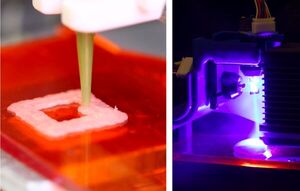
Engineers figured out how to cook 3D-printed chicken with lasers
"Who hasn't dreamt of coming home after a long day and simply pressing a few buttons to get a hot, home-cooked 3D-printed meal, courtesy of one's digital personal chef? It might make microwaves and conventional frozen TV dinners obsolete. Engineers at Columbia University are trying to make that fantasy a reality, and they've now figured out how to simultaneously 3D-print and cook layers of pureed chicken, according to a recent paper published in the journal npj Science of Food. Sure, it's not on the same level as the Star Trek replicator, which could synthesize complete meals on demand, but it's a start. Co-author Hob Lipson runs the Creative Machines Lab at Columbia University, where the research was conducted. His team first introduced 3D printing of food items back in 2007, using the Fab@Home personal fabrication system to create multimaterial edible 3D objects with cake frosting, chocolate, processed cheese, and peanut butter." [...]
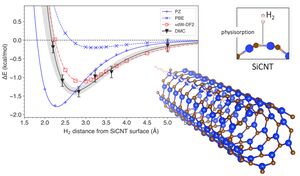
New Way to Simulate Hydrogen Storage Efficiency of Materials with High Accuracy
"Scientists develop new computational method that can simulate hydrogen storage on silicon carbide nanotubes much more accurately than conventional methods The development of hydrogen technology is invaluable to the future of clean energy, but its progress is hampered by the difficulty in hydrogen storage at room temperature. Computational predictions for storage design go a long way towards reducing the time and cost of development, but how trustworthy are these predictions? Scientists from Japan and USA now create an accurate model to compare with existing methods for the prediction of hydrogen storage on silicon carbide nanotubes. Hydrogen energy has the potential to be a key measure to meet the United Nations net zero emissions target, but its industrial use has been hindered by the difficulty in its storage and handling. Hydrogen becomes a gas at a very low temperature (-252°C), which makes its storage at room temperature challenging. The interaction between hydrogen and its storage material is simply too weak to persist at room temperature." [...]
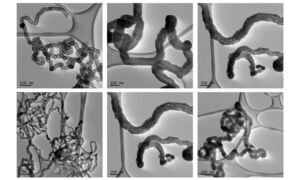
From recycling to upcycling: A smarter way of dealing with plastic
"Researchers have developed a clean and cost-effective way to upcycle used plastic, transforming it into valuable nanomaterials and high-quality fuel. Key points - New tech produces carbon nanotubes and clean liquid fuel from used plastic - Smart solution for upcycling plastic and agricultural waste simultaneously - Circular economy approach to help turn two massive waste streams into genuine revenue Globally only about 20% of waste plastics are recycled. Boosting that figure remains a challenge as recycling plastic cleanly can be expensive and usually produces lower-value products, often making it financially unviable. The new method from researchers at RMIT University can produce high-value products from plastic – carbon nanotubes and clean liquid fuel – while simultaneously upcycling agricultural and organic waste. The team’s two-step process, revealed in the Journal of Environmental Management, converts organic waste into a carbon-rich and high-value form of charcoal, then uses this as a catalyst to upcycle the plastic. Lead researcher Associate Professor Kalpit Shah said upcycling two massive waste streams through one circular economy approach could deliver significant financial and environmental benefits." [...]

Cracking Open Strong Field Quantum Electrodynamics
"Berkeley Lab’s researchers’ unique capabilities aided international effort to probe fundamental questions in physics A newly published theoretical and computer modeling study suggests that the world’s most powerful lasers might finally crack the elusive physics behind some of the most extreme phenomena in the universe – gamma ray bursts, pulsar magnetospheres, and more. The international research team behind the study includes researchers from Lawrence Berkeley National Laboratory (Berkeley Lab) and France’s Alternative Energies and Atomic Energy Commission (CEA-LIDYL). They report their findings in the prestigious journal Physical Review Letters. The research team was led by CEA’s Henri Vincenti, who proposed the main physical concept. Jean-Luc Vay and Andrew Myers, of Berkeley Lab’s Accelerator Technology and Applied Physics (ATAP) Division and Computational Research Division, respectively, led development of the simulation code used for the research. (Vincenti previously worked at Berkeley Lab as a Marie Curie Research Fellow and remains an ATAP affiliate and frequent collaborator.)" [...]

Topological Polariton-Based Structure: Scientists Get One Step Closer to Next-Gen Optoelectronic Devices
"Researchers from ITMO University, the University of Sheffield, and the City College of New York have proposed a metasurface with unique topological properties. The proposed system is based on a photonic topological insulator integrated with a two-dimensional semiconductor and stimulates polaritons – quasiparticles that combine the properties of topological photons and excitons. The discovery opens the door to more efficient light control and hence advanced transmission and processing of optical information. The related article is published in Nature Communications. Two-dimensional materials in photonics The creation of efficient light control systems is one of the major challenges for photonics today. Nothing in the universe is faster than light." [...]
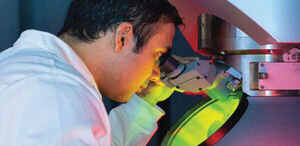
Full color LEDs cut down to size
"Tiny light-emitting devices that can create all the colors in the rainbow are essential for the next generation of phones and screens. Micrometer-scale light-emitting diodes (μLEDs) are the ideal building block for next-generation microLED displays used in head-mounted monitors, mobile phones and televisions because they are bright, respond quickly, offer longevity and consume little energy. KAUST researchers have shown that these scaled-down devices can efficiently emit light across the entire visible-light spectrum. Just as with conventional LED displays, full-color μLEDs products will require arrays of blue, green and red light sources. Nitride-based alloys are a group of semiconducting materials that offer one route to achieving this because, with the right chemical mix, they can emit all three colors. However, when nitride devices are reduced in size to micrometer scales, they become very poor emitters of light." [...]
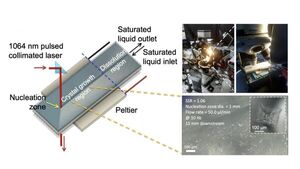
Researchers investigate how lasers can lead to cleaner crystallization process
"Microscopic experiments could make massive industrial processes more sustainable: researchers investigate laser-induced crystallization using microfluidics. When Bruce Garetz, professor of chemical and biomolecular engineering, examined the test tubes that his student had exposed to laser light in his lab, he noticed something odd: The tubes that once contained liquid solution now contained what appeared to be crystals, implying that nucleation and crystal growth, two steps of the process of crystallization, had occurred. Why had this happened? After scouring scientific literature for explanations, he found no answers. Now Garetz and colleague Ryan Hartman, associate professor of chemical and biomolecular engineering, will have a chance to pull the curtain back on this process. On June 16, 2021, the pair received a $453,103 grant from the National Science Foundation (NSF) to design and study microfluidic non-photochemical, laser-induced nucleation (NPLIN) of preselected organic molecules." [...]

Beam diagnostics for future laser wakefield accelerators
"For decades, particle accelerators have been getting bigger and bigger. In the meantime, ring accelerators with circumferences of many kilometres have reached a practical limit. Linear accelerators in the GHz range also require very long construction lengths. For some years now, however, an alternative is explored: "tabletop particle accelerators" based on the laser excitation of charge waves in plasmas (laser wakefield). Such compact particle accelerators would be particularly interesting for future accelerator-driven light sources, but are also being investigated for high-energy physics. A team from Helmholtz-Zentrum Berlin (HZB) and the Physikalisch-Technische Bundesanstalt (PTB) has developed a method to precisely measure the cross-section of electron bunches accelerated in this way." [...]
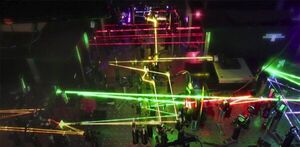
Researchers identify and clear efficiency hurdle for organic solar cells
"Researchers have identified a key mechanism responsible for the lower efficiencies of organic solar cells and shown a way that this hurdle might be overcome. The researchers, led by the University of Cambridge, identified a loss pathway in organic solar cells which makes them less efficient than silicon-based cells at converting sunlight into electricity. In addition, they identified a way to suppress this pathway by manipulating molecules inside the solar cell to prevent the loss of electrical current through an undesirable state, known as a triplet exciton. Their results, reported in the journal Nature, suggest that it could be possible for organic solar cells to compete more closely with silicon-based cells for efficiency. Organic solar cells, which are flexible, semi-transparent, and cheap, can greatly expand the range of applications for solar technology. They could be wrapped around the exteriors of buildings and can be used for the efficient recycling of the energy used for indoor lighting, neither of which are possible with conventional silicon panels." [...]

Wireless strain sensors cracked up to be better
"Incorporating regular cracks in electrodes for wireless strain sensors brings surprisingly better sensitivity. Controlling the structure of fragmented electrodes composed of carbon nanotubes could offer improved wireless monitoring of the strain on materials in a wide range of applications. “This opens endless possibilities for every situation where accurate wireless monitoring of structures is important,” says Gilles Lubineau, Professor of Mechanical Engineering at KAUST. Lubineau developed the technology with postdoc Hussein Nesser, who adds: “Our sensor can directly be used to assess, in-situ and with great accuracy, the strain exerted on materials.” Monitoring the strains imposed on materials is crucial for checking the safety of everything from buildings and bridges to ships and aircraft. Strain sensors are also important subdevices for monitoring aspects of health, sports performance and robotics. Natural, manufactured and living structures are all exposed to stresses and strains that can compromise their integrity." [...]
Documentação
A documentação é parte essencial do processo de aprendizagem e a Internet além de artigos interessantes de explorar também tem alguma documentação em formato PDF interessante de ler. Todos os links aqui apresentados são para conteúdo disponibilizado livremente pelo editor do livro.
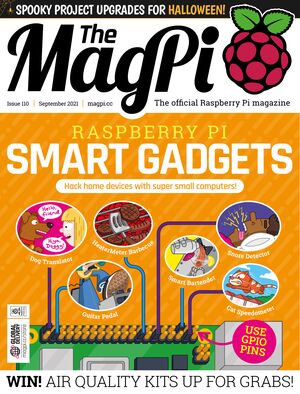
The MagPi 110
"Inside The MagPi magazine #110 - Raspberry Pi Smart Gadgets. Hack your home with these incredible builds. - Spooky project upgrades for Halloween. Give the local kids a fright-fest! - Build an Android tablet. Make your own tablet computer with Raspberry Pi." [...]
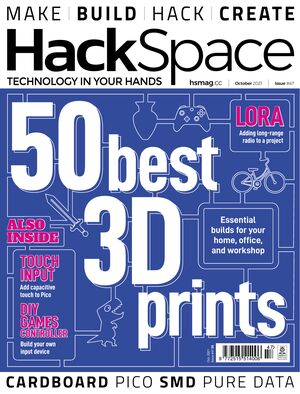
HackSpace magazine #47
"If your 3D printer is looking a little dusty and unloved, now’s the time to put it to work: we’ve 50 of the best 3D prints to improve your home, office, workshop and more. From functional to frivolous, we’ve got ideas for you. It’s time to unleash the awesome power of your printer! - Oskitone: where 3D printing meets analogue synth goodness - Pure Data: make music with this awesome graphical programming language - Surface mount soldering: solder the way the professionals do it - Cardboard tubes: do something useful with toilet roll tubes" [...]
Projetos Maker
Diversos Projetos interessantes.
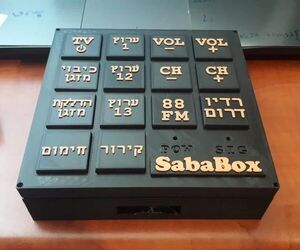
Sababox - Elderly Friendly Remote Control
"The world’s population is getting older. Studies show that companies will have to adjust their products and marketing channels for older crowds. A well known problem is for elderly people to be able to enjoy their TV as they are not confident with their ability to get to the desired content, and also concern of “breaking it”, taking the TV out of order until someone will fix it for them. Many of those concerns are caused by our standard remote controls which contains over 30 different buttons over very small space even though most of us barely use more than 5. Our remote changes how we think of remotes from a tiny, light device with a noisy interface- To an accessible, clean interface that is designated for elderly users. Bigger buttons, with the vital minimum number of them should provide friendly interface for the users." [...]

IoT Wireless Infrared Kitchen (Cooking) Thermometer
"Monitor and track temperature remotely while cooking foods with pots, pans, saucepans, etc., on Tuya Cloud compatible w/ Android and iOS. I am fond of cooking and trying different recipes to expand my knowledge about foods. And, as an electronics enthusiast, I enjoy tinkering with gadgets to get more precise measurements while cooking. In that way, I ensure delicious and consistent outcomes with little effort. To measure the internal temperature of foods (roasts, steaks, etc. ), I utilize a meat thermometer while cooking." [...]

Automatic Volume Adjuster for LOUD MOVIE MUSIC
"In this project I will solve one of the biggest problems I have with modern movies. The problem is that the conversation volume is way too low in comparison to the music volume. That is why I combined an Arduino microcontroller with a microphone and an IR LED in order to create an automatic volume adjuster. It basically detects when loud movie music starts playing, lowers the volume and then brings the volume back up when the music is over. Let's get started! " [...]
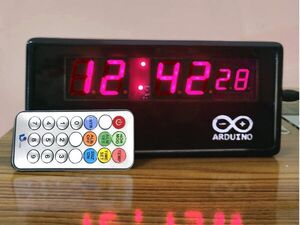
Digital Clock with IR Remote Control using Arduino Nano
"Digital Clock With Hour/Minute/Second/ Temperature display and features Alarm/snooze/Hour Chime with a full function IR remote Control. I have earlier published a Digital Clock project, and that was my first project on Arduino. That project has only limited features ( even without a facility for time setting ) due to constraints in getting sufficient no of pins on Arduino Nano to write the program. Here by adding an InfraRed remote, it give me flexibility of incorporating all the features that requires ( may be more if required), with out the need of extra pins and also avoiding slide and push switches. Also IR remote make the clock very compact and convenient to set and use. Also avoiding bread board, jumpers etc, I used a home made PCB to make the project compact and an usable for normal home use I am publishing this project as a new one, since the previous project’s sketch was extensively changed to incorporate IR remote and adding additional features, and also it is a finished project." [...]

Use Raspberry Pi or Arduino: DIY LED Matrix Colored Lights
"This matrix colored light uses standard WS2812B LEDs to form a cylindrical lamp body, which is finally combined by a wooden frame. The lighting effect is pretty good, let's try to make it. Materials 790×384 cardboard×a few (1.5mm wood board is used here) WS2812b LED×100 (30 pcs / m) Raspberry Pi or Arduino ×1 Wooden patches or other flexible materials × several Wire × several" [...]

3D Print Your Own Nanoleaf Project - Alexa, Hue and App Integration
"Meet Geoleaf, my low cost and 3D printable version of Nanoleaf lighting panels. I have wanted some Nanoleaf lights for a long time but the price has always been too high for me. So I thought I would set about creating my own version using a 3D printer. Each lit panel works out at about £3.40 in materials to make and I’m very happy with the end result. You can assemble them in any order to suit your wall space and other shapes can be included such as the optional square panels. I have offset them from the surface to allow a stylish glow out across the wall in the evenings and the panels themselves are bright enough to be seen in the daytime." [...]

Irrigation system
"Measures soil moisture and lighting. watering plants when humidity is low and no sun through valve control. log data to SD card. This system is for automating watering plants at home, it release you from manually watering the plants and it can save water and do the watering your garden more precise. The software logic uses moisture light and temperature sensors to activate solenoid valve or/and water pump. It have button to change sensor reading value display and water information on tft display." [...]

The Moncky project
"Creating a complete working retro 16-bit computer from scratch in the style of the C64, CPC 464 and alike using an FPGA. Hi, welcome to the home of the Moncky project! The goal is to create a complete working retro 16-bit computer but with modern technology (FPGA board). It is a work in progress. A lot of ideas are still floating around :-) At the heart is a 16-bit single cycle self-made RISC processor (not pipelined): the Moncky-3. In this project you can also find its predecessors." [...]
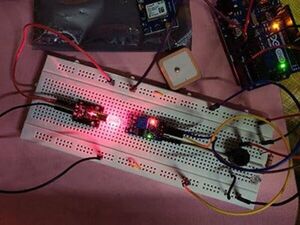
A Bolt IoT-based Automobile Anti-theft System
"This project is developed to provide a user with a solution to track their vehicle in real-time if someone tries to steal or break into it. Cars are slowly becoming a necessity now owing to the pandemic situation prevalent all over the world. It becomes quite important for the owner of an automobile to be able to protect their cars from theft. Some people simply do not have a garage to keep their cars in. Others need a security solution for times when they park their car in unknown spots. These problems demand a solution to be able to track down their car in real-time if the car gets stolen." [...]

Tiny, Solar Powered, Light Seeking BEAM Bot (Mini Photopopper)
"Today I will show you how I made this tiny little robot! Since I first mentioned the word in an Instructable and got a couple questions about it, every new BEAM Instructable I feel the need to explain my understanding of the term "BEAM robotics". Wikipedia will tell you that BEAM stands for Biology Electronics Aesthetics and Mechanics, and though I have heard conflicting theories about the name in the past I do feel that BEAM embodies these aspects. It is a style of electronics developed in the late 90s and early 2000s using mostly found components in ways that are quite elegant or clever, in order to create the most basic intelligent robots. This particular style of robot know as a photovore, phototrope or photopopper, meaning it uses some very simple logic to locomote toward light. Making tiny photopoppers has been done before, indeed even I have tried (in the video you can see my attempt from 2018 built on a PCB I designed), but I am really happy with how this particular one turned out and am excited to share the process with you all!." [...]
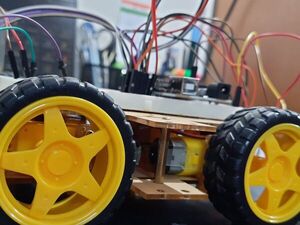
Phone Controlled Robot Car using Wi-Fi Module
"Remotely controlled car - IoT based project using Wi-Fi Module and MIT App Inventor with intuitive control. A step-by-step guide! This is a fairly simple IoT project with a lot of learning opportunities. I'll begin with a detailed overview of the steps one should go through before directly diving into creating the final product. While there was already a lot of material on DIY robot cars available on the internet, a lot of painstaking days went by without any significant progress while working on this particular project, especially since I'm a fair beginner in the subject of IoT. So, I bring to you a step-by-step guide for how I successfully got through with this project and all the issues I ran into (and obviously how to overcome them)." [...]
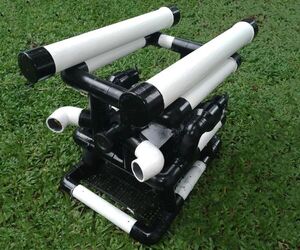
Make Your Own Underwater ROV
"One day while I was on YouTube I saw a man is trying to recover something that missed in a lake using an underwater robot. I was so excited to know what is the magical robot and how it works. After searching and reading about that robot, I found it's a robot called underwater ROV(Remotely operated vehicle). Just not only taking an idea about ROV, I want to have my own one. When I seared for an ROV on eBay the result always came with the cost is higher than 1000$. But I am also cheap." [...]

DIY Smart Window Blinds To Home Assistant
"For a long time I’ve been wishing for automatic window blinds for my living room. Those three window blinds are always closed and opened at the same time so it’s “too much work” (yes, laziness is the most common motivation for smart home systems). However, there’s no affordable ready made solutions in market so why not to do it myself? Basically everything needed is an ESP8266, power supply and a servo. Rest of the components can tinkered and boughr from a local hardware stores. So, here’s a solution/guide how I made my blinds smart." [...]

slide-rules-generator
"A generator for slide rules! Features - Outputs SVGs, so you can either print or laser cut/engrave slides - Generates scales in linear, circular, and spiral format - Determines the best partitioning from a list of possibilities, given a "minimum tick distance" - Many different functions supported, including LogLog, trig, inverted, nth root and nth power scales - Adding new tick functions, transforms, and tick generation schemes is straightforward No UI yet, so this is library is really only for the particularly determined. Want documentation? File an issue and we can go over what you want to see and where you can help! " [...]
Secção Videos
Videos interessantes.
That's all Folks!



